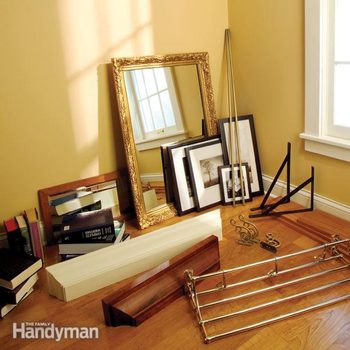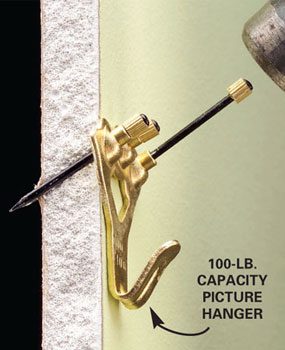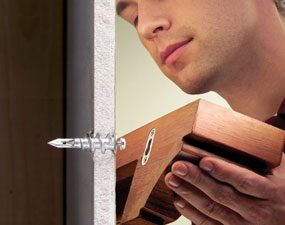Costco Bathroom Towel Bars
Hanging Shelves, Hanging Mirrors and Hanging Towel Bars
Can't find a stud? One of these 5 hard-working, hollow-wall anchors will do the job
 Family Handyman
Family Handyman
We've chosen five hollow-wall anchors that cover a range of weight requirements, from lightweight knickknack shelves all the way up to heavy-duty utility shelf brackets. Of course, it's always best to anchor into solid wood if you can, but for those situations where it just isn't possible, these five anchors will provide superior holding power with the least amount of hassle.
You might also like: TBD
- Time
- Complexity
- Cost
- An hour or less
- Beginner
- Less than $20
Pictures and mirrors

Triple-nail hanger
How they work

Close-up

Photo 1: Drive the nails
Slide the small nails (included) through the angled hole and tap them into the wall with a hammer. To remove the hanger, grab the end of the nail with pliers and twist it out.
You can buy special plastic anchors for hanging heavy mirrors and pictures, but you'll be left with a sizable hole to repair if you decide to relocate the object. The best choice is to do what the pros do. Choose a picture hanger based on the weight of the picture or mirror. The triple nail version we show here holds up to 100 lbs., more than enough for even the heaviest mirrors. But if you're worried, just use a pair of them spaced about a foot apart for an extra margin of safety. Using picture hangers in pairs like this also prevents the picture or mirror from tipping if it slides on the hanging wire. You'll find this type of hanger in most full-service hardware stores and home centers or at picture framing shops.
Light-duty shelving

Screw-in anchor
How they work

Close-up

Photo 1: Snug in the anchor
Center the anchor point on your mark and spin it in with a drill or by hand. Slow down when the large threads engage, and stop when the anchor is snug and nearly flush.

Photo 2: Thread the screw into the anchor
Slowly drive a No. 6 screw into the anchor. For shelves like this with keyhole mounting, leave enough space behind the screwhead for the metal keyhole to slip over.
Most lightweight shelves like this one come with expanding plastic anchors, but I wouldn't rely on them. Instead use these self-drilling, screw-in type anchors. They're rated to hold about 30 to 50 lbs. each (depending on the size) and take only seconds to install. These anchors (metal or plastic versions) work great for hanging small shelves and other decorative items that aren't subject to much use and don't have to support a lot of weight. On a ceiling, don't use these anchors to hang anything heavier than a smoke detector.
You can screw the anchors in by hand with a No. 2 Phillips screwdriver, but a drill with a No. 2 driver bit works better. Slow the drill to a crawl as soon as the large threads engage in the drywall. Then carefully turn the fastener until the face is almost flush. Overtightening will damage the drywall and compromise the holding power. These same precautions apply to the screw. Turn it in slowly and stop as soon as the screw is snug to the object you're attaching. Overtightening will strip the threads. If the anchor loosens and spins, you'll have to back it out and replace it with a toggle-type anchor in the same hole.
Heavy shelves

Toggler bolt
How they work

Close-up

Photo 1: Drill
Drill the recommended size hole and slip the metal flange through it.

Photo 2: Pull
Pull on the straps until the metal flange is tight to the backside of the drywall while you slide the plastic ring tight to the wall.

Photo 3: Bend
Bend the plastic straps and snap them off flush to the wall.
It's best to locate a stud or other framing member to mount shelf brackets that support heavy weight. But if you have to mount a shelf bracket on drywall, use these Toggler anchors. They're easier to use and stronger than standard wing-type toggle bolts. Plus, you can remove the machine screw without losing the toggle inside the wall, which allows you to mount items that may occasionally need to be taken down and reinstalled.
The only drawbacks to Toggler bolts are that they're a little harder to find and slightly more expensive than standard "molly" bolts. We found ours at a local home center, and they're also available online. The photos below show how to install Toggler bolts.
Curtain-rod brackets, towel bars and coat hooks

Self-drilling metal toggle
How they work

Close-up

Photo 1: Drive the toggle
Mark the mounting holes and drive an E-Z Toggle in at each mark. Slow down as soon as the threads engage in the drywall. Slowly tighten the toggle until it's snug and nearly flush.

Photo 2: Tighten the screw
Slide the screw through the bracket and thread it into the anchor. Tighten the screw to draw the metal flange against the back of the drywall.
Curtain rod brackets dangling from loose anchors or towel bars pulled out of the wall are all too common. That's because these jobs require an anchor that can stand up to constant jostling and tugging. And the plastic anchors usually provided just aren't up to the task. Buy some of these slick, self-drilling metal toggles instead. They're a little more expensive, but they're easy to install and hold like crazy. You simply screw them in at the desired locations (Photo1). Then as you tighten the mounting screw, the metal flange flips out and is drawn tight to the backside of the drywall. You can remove the object for painting, and the anchor will remain in the wall, ready for reuse.
The only drawback to these anchors is that you have to use the screw provided or one with the same type of thread. This may mean abandoning the decorative screws included with your hardware. You may have to spray-paint the screwheads to match or search for a decorative screw with the same threads.
Install these toggles just like their smaller cousins. But make sure to probe the wall first to determine if there's room for the metal flange to flip open. The E-Z Toggle we're using has arrows on the face to show the alignment of the flange when it opens. This is handy if you have two toggles close together and don't want the flanges to clash, or to prevent the flange from hitting a stud that's close to the edge of the toggle. Turn the E-Z Toggle in or out slightly to adjust the orientation of the metal flange.
4 Tips for Choosing Anchors
1. Probe the wall before choosing an anchor. Before you shop for anchors, probe the wall to determine the thickness of the covering, the depth of the cavity and the presence of any obstructions. This simple step will only take a few minutes and can make the difference between a smooth installation and a frustrating experience. Drill a 1/8-in. hole through the drywall or plaster at the anchor locations. Bend a 1-in. long, 90-degree hook on the end of a coat hanger or other stiff wire and slide it through the hole. Twirl it to feel for obstructions. Push it all the way in and make a mark flush to the wall with a marker or tape. Now pull it tight to the backside of the wall covering and make a second mark. Remove the wire and measure from the bend to your marks to determine the thickness of the wall covering and the depth of the cavity. With this information, you can select the best anchor and install it without the risk of hitting a plumbing pipe or electrical cable.
2. Match the anchor to the wall thickness . Check the package to see what type and thickness of wall the anchors work in. For example, some plastic toggles have a grip range of 3/8 in. to 1/2 in. and won't work on plaster walls that are 3/4 in. thick. Most anchors are available in a number of sizes with different "grip ranges," so it shouldn't be hard to locate one that will work.
3. Use the right screw for the anchor. Some anchors come with sheet metal screws, but you can usually substitute a similar size wood screw or drywall screw. Metal toggles, on the other hand, only accept screws that match their threads. If screws are provided with the anchors, check the package for the "maximum fixture thickness." If you're hanging a 3/4-in. thick wood shelf, for example, and the maximum fixture thickness listed is 5/8 in., you'll have to buy longer screws of the same type. If you want to use the decorative screws that are included with the item you're installing, then look for an anchor that will work with those screws.
4. Make sure there's room in the wall. All of the anchors we show here work in standard 2×4 walls, as long as they don't hit pipes, ducts, wood blocking or other obstructions. But choose your anchor carefully if you're mounting to exterior basement walls, walls in manufactured homes or other unusual wall types. Metal toggles, for example, require a certain amount of depth and space for the toggle to flip open. You can't use them in thin walls or walls with rigid foam insulation.
Medium-duty shelves and racks

Plastic toggle
How they work

Close-up

Photo 1: Drill the hole
Drill a hole sized to the anchor. Then fold the anchor's wings flat and push it through the hole.

Photo 2: Tap the anchor
Tap the anchor gently until the flange rests against the wall.

Photo 3: Turn in the screws
Drive screws slowly through the standard into the anchors. Stop as soon as the screw is snug to the standard and the standard is snug to the wall.
Most shelf brackets and standards have several mounting holes, so you can rely on the combined strength of many fasteners to support them. But they require an anchor that won't pull out of the wall when you tighten the screw. Plastic toggles meet both of these requirements. They're rated to support about 30 to 50 lbs. each and are designed to prevent pullout by hooking the backside of the drywall.
You have to drill a hole for these anchors. Hold the shelf standard at the right height and use a level to align it vertically (plumb). Mark the hole locations with a sharp pencil. Drill the recommended hole size (3/8 in. for these 5/8-in. Kwik-Tog anchors) at each mark. Then install the anchors as shown in the photos. Some types of plastic toggles require you to "pop" them out after sliding them into the hole. Take care not to overtighten the screws or the plastic will strip and the screw won't hold.
Required Tools for this Project
Have the necessary tools for this DIY project lined up before you start—you'll save time and frustration.
Required Materials for this Project
Avoid last-minute shopping trips by having all your materials ready ahead of time. Here's a list.
Similar Projects
Source: https://www.familyhandyman.com/project/hanging-shelves-hanging-mirrors-and-hanging-towel-bars/



0 Comments